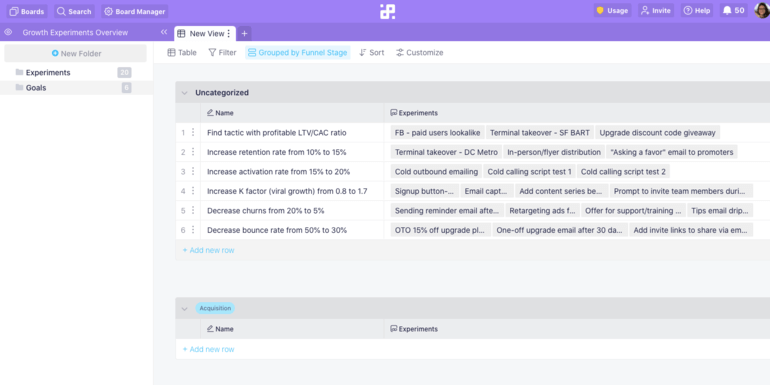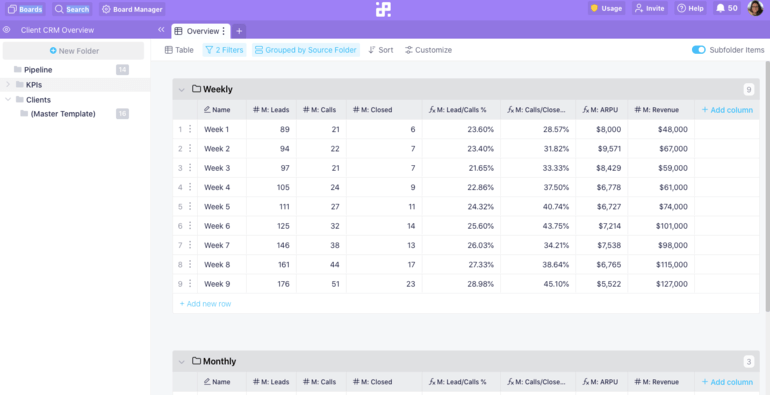5 Steps to Setting and Tracking KPIs in 2021
KPIs are key performance indicators, metrics that help you evaluate the success of your efforts. Without KPIs, it’s hard to tell if you’re going in the right direction, but choosing the wrong metrics or focusing on too few or too many can lead you astray.
What is the best way to choose which KPIs to track and to measure your progress? We follow a 5-step process that we have developed based on our experience and growth, and hopefully, you will benefit from it.
5 Steps to Setting and Tracking KPIs in 2021
1. Set Goals
Before choosing KPIs, you need to set goals you want to achieve. This way, you’ll have a better idea of what metrics are important to follow while working on your goals.
SMART Goals
SMART is an acronym describing a popular set of guidelines for goal setting. By following the 5 rules of this method, you can better define your goals and increase your chances for success.
How to turn your goals into SMART goals? Here are the 5 rules you need to follow:
- Specific—You want to use exact metrics, numbers, and dates whenever you can. The more specific you are, the easier it will be to track the progress of the set goal and determine if you have achieved it in the end. For example, if you’re looking to grow your social media presence, it would help to set a goal like “get a 20% increase in followers on LinkedIn by the end of Q2”.
- Measurable—Try to steer clear of goals that are impossible or hard to measure, like team productivity, brand awareness (this can be broken down into several metrics like search volume, website traffic, etc. but depends heavily on the strategy and channels you use for brand awareness), customer satisfaction, etc. Try to define hard metrics that are the most important for these goals and redefine them in a way that’s easier to track in numbers.
- Attainable—While sometimes you need to set the bar high in order to succeed, you should be realistic most of the time. We’ll talk about stretch goals a bit later, but for now, let’s focus on being realistic with each goal. The longer you have been tracking your KPIs, the easier it will be for you to calculate the desired outcome based on historical data and growth trends.
- Realistic—Although this sounds similar to attainable, there is a big difference. Sometimes you’ll set a goal that’s normally attainable, but due to some circumstances it is not realistic to expect that you’ll meet it. For example, if your engineering team is already struggling with a complex project, adding another one, no matter how small and seemingly easy, can
- Time-bound—As mentioned before, you need to be as specific as possible, and adding a deadline to every goal is a must. If necessary, you can leave some wiggle room and define the deadline as “the first week of September”, but try to aim for exact dates like “September 1st”.
Stretch Goals
Now, forget everything we said about SMART goals and go above and beyond! Stretch goals are goals that are intentionally set very high and often aren’t expected to be accomplished one hundred percent. But why would you set a goal so high that you’ll most likely fail to meet it? Because there is no growth unless you step out of your comfort zone.
A balanced combination of SMART and stretch goals will give you the push to achieve best results without overwhelming your team.
2. Define KPIs
Take this example: you want 20% more daily website visitors by the end of this quarter. But what is your strategy for drawing more people in? Do you want to invest in paid ads and attract paid traffic? Are you planning on offering more quality content on your blog to increase organic traffic? Or perhaps you’ll participate in a conference to promote your company and bring referral traffic from outside sources? Based on the initiatives you want to take, it makes sense to not only measure overall website traffic but to define KPIs for each initiative (like daily organic traffic) to be able to determine what has the most impact towards reaching your goal.
The takeaway from this example is that once you set a goal, you have to define how you plan to reach that goal and assign KPIs accordingly. If you’re (like us) using an Agile approach to things, this means you’ll give up on ideas, start new initiatives, and often change course along the way. That’s great! One of the reasons you want to set and track KPIs in the first place is to be able to see where you’re going and change what isn’t working until it’s too late.
But is there a thing such as too many or too few KPIs?
North Star Metric and Analysis Paralysis
Maybe you’ve heard of the term North Star Metric (NSM)—a single metric that is the most indicative of your company’s long-term growth. These are the 6 most common types of North Star Metrics:
- Revenue—the amount of money your company generates. Examples: MRR (monthly recurring revenue), ARR (annual recurring revenue), ARPU (average revenue per user), ARPA (average revenue per account), etc.
- Customer growth—the number of paying users you have. Examples: weekly paid users, number of lifetime deals purchased, churn rate, etc.
- Growth efficiency—how much you earn vs. how much you spend. Examples: CAC (customer acquisition cost), LTV (lifetime value), GEI (growth efficiency index), etc.
- Engagement growth—the number of users actively engaging with your product. Examples: DAU (daily active users), MAU (monthly active users), ER (engagement rate), etc.
- Consumption growth—the measure of how much the users are consuming the product or service you are offering. A common metric for subscription-based services or online marketplaces. Examples: number of food delivery orders, hours of streamed music, number of rides, etc.
- User experience—the indicator of overall user satisfaction with your product and services. Examples: NPS (net promoter score), CSAT (customer satisfaction score), etc.
Even though a North Star metric can be an excellent indicator of your company’s success, don’t make the mistake of focusing on a single thing. Most aforementioned North Star metrics are affected by several other KPIs and shouldn’t be observed in a vacuum. But there is the flip side of the coin: having too many KPIs and suffering from analysis paralysis.
Besides sounding like the title of a Radiohead song, analysis paralysis is what happens when you overanalyze a problem—by setting and tracking too many KPIs you can get lost in what drives growth and what is of no importance. In Infinity, we use the OKR approach—a goal-setting framework that ties objectives to key results. Each objective is a clearly defined goal tied to 3-5 key results, which has proved to be the optimal number of KPIs for us.
3. Set KPI Targets
Let’s return to the visitor growth example from before and say that you decided to have both paid and organic initiatives in order to reach the desired 20% increase in website traffic. We’ll ignore direct search and other channels for the sake of simplicity.
Current data:
1,000 visitors per day.
800 (80%) from paid traffic.
200 (20%) from organic traffic.
Imagine that, based on current data, you calculated that a 22.5% increase in paid traffic and a 10% increase in organic traffic will provide enough visitors to meet the goal.
Goal:
1,200 visitors per day by the end of the quarter.
980 visitors from paid traffic (180 more or 22.5% increase in paid traffic).
220 visitors from organic traffic (20 more or 10% increase in organic traffic).
At the end of the quarter, you may find that a particularly successful paid ads campaign boosted paid traffic by 25% but your organic efforts brought only 2.5% more traffic. If the majority of your visitors come from paid sources, a 25% increase can be enough to ensure that you achieve the desired goal, even though you failed to meet one of two targets.
End results:
1,000 daily visitors from paid traffic (25% increase in paid traffic). Target hit.
205 daily visitors from organic traffic (2.5% increase in organic traffic). Target missed.
1,205 overall daily visitors. Goal met.
Of course, you’d never expect to have the same amount of visitors every day nor you’d create target percentages this precisely. This was just an exercise to show that you can think of KPI targets as mini-goals that help you work towards your actual goals. If a goal is represented by 3 different KPIs, then each will have its own target but it doesn’t necessarily mean that you need to hit all three targets to achieve the end goal.
How to set attainable KPI targets?
The more historical data on KPIs you have, the easier it will be to calculate realistic KPI targets. If your company has seen a trend of increasing its yearly revenue by between 1 and 4 percent in the past 5 years, it would be unrealistic to expect a 10% growth.
For early-stage companies with no prior data, setting targets may feel like shooting in the dark. When in doubt, take a look at what the competitors are doing and what growth rates are considered good for your industry-specific KPIs.
Keep in mind that early growth data shouldn’t be used as a benchmark because the lower your starting metrics are, the greater the growth percentage will be. Growing a customer base from 5 to 10 people shows a 50% increase while growing a customer base from 10,000 to 10,005 people shows a 0.05% increase.
4. Track KPIs
For KPIs to have an effect on your business, you need to establish a way of tracking them regularly and consistently. It’s good practice to have one person responsible for KPI tracking, but make sure to have at least one other team member familiarized with the process to take over when needed.
Even better, create a how-to document explaining the process of collecting KPI data along with relevant login details and links that will help onboard new team members faster.
Data sources
Define the data sources from which you are going to pull data, and specify the way you will use these sources to avoid skewed results. Some analytics tools are very complex and you need to make sure that every person in charge of data collection is using the same set of rules and filtering. For instance, if you use Google Analytics to measure the number of organic visits to your website, you need to set the default channel grouping to organic search only.
Tracking frequency
The frequency of tracking your KPIs depends on the type of metrics you chose to follow. Some events happen so rarely that it makes the most sense to track them monthly,
If you’re measuring social media KPIs, sometimes it is a good idea to track them hourly to discover the best time of day to post and engage with your audience. But in most cases, collecting and comparing KPI data every week gives a large enough timeframe to notice trends and derive conclusions from your data.
5. Analyze Results
You have carefully chosen and tracked your KPIs, and now you have a bunch of data at your disposal. The success of this final step will determine if everything you have done so far was in vain. The three most important steps in the process of analyzing KPI data are to compare it, gain insights, and decide on the best course of action.
Compare datasets
The standard way of analyzing metrics is to calculate the growth rate of the latest data compared to the previous values. The numbers will typically oscillate between a positive and negative growth as the weeks go by, which is why you should take time at the end of each month and compare the data to the previous month (or the previous year, if you have enough data).
Infinity tip: Infinity lets you use formulas to avoid having to manually calculate growth rate, percentages, and other statistics every time.
If you’re a new company, one of the trickiest parts of analyzing your KPIs will be the lack of historical data. It’s hard to know if you’re doing well when there’s nothing to compare your results with. Until you accumulate enough weeks and months of data, it helps to do some digging and look for typical growth rates for common startup KPIs.
Gain insights
Numbers can’t tell you anything without context, which is why you should always analyze the results together with your whole team. While there will be bad weeks and missed goals, you should always encourage open discussions and honest feedback.
If there is a significant peak or descending top, try to discover the reason behind it. Always look at the bigger picture and take into account everything from the time of the year (was it the holiday season when people’s shopping habits change?) to any internal events that happened in the observed timeframe (product functionality issues, changes to the company website, launch of a new campaign, etc.).
Suggest the next steps
The last step in the process is to decide what to do next based on the insights you have gathered from your KPI data. If everything is running smoothly and you’re seeing steady growth, there is room to brainstorm future initiatives based on what proved to be working for you. If you’re lagging behind and losing profit, it’s time to reconsider your strategy and try a different approach as soon as possible.
Conclusion
Hopefully, you’ll be able to use this 5-step process of setting and tracking KPIs to improve your current processes. If you need an extra push, check out some of our templates that are great for everything from creating goals to keeping track of targets and KPIs.st











